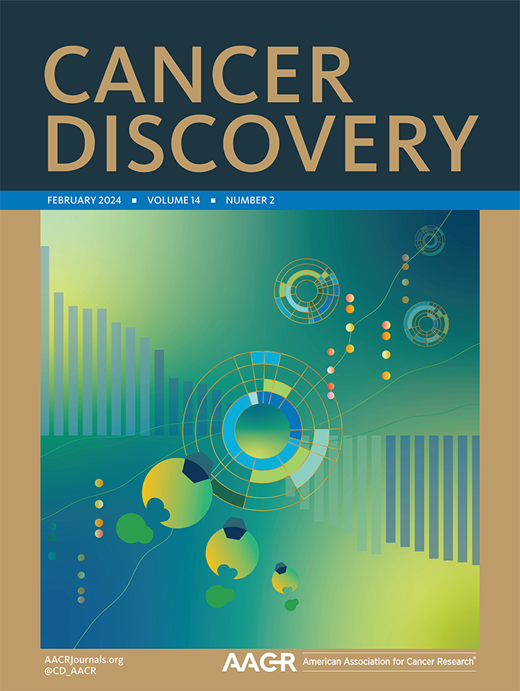Copper Drives Remodeling of Metabolic State and Progression of Clear Cell Renal Cell Carcinoma.
IF 29.7
1区 医学
Q1 ONCOLOGY
引用次数: 0
Abstract
Significance: The work establishes a requirement for glucose-dependent coordination between energy production and redox homeostasis, which is fundamental for the survival of cancer cells that accumulate Cu and contributes to tumor growth.
铜驱动新陈代谢状态的重塑和透明细胞肾细胞癌的进展。
铜(Cu)是细胞色素 c 氧化酶(CuCOX)的辅助因子,是有氧线粒体呼吸不可或缺的物质。这项研究发现,晚期透明细胞肾细胞癌(ccRCC)会积累铜,并将其分配给CuCOX。我们采用了一系列正交方法,包括代谢组学、脂质组学、同位素标记的葡萄糖和谷氨酰胺通量分析以及肿瘤样本、细胞系、异种移植和 PDX 模型的转录组学,并结合基因和药物干预,探讨了 Cu 在 ccRCC 中的作用。Cu水平升高会刺激CuCOX的生物生成,提供生物能和生物合成益处,从而促进肿瘤生长。葡萄糖依赖性谷胱甘肽的产生补充了这一作用,促进了解毒并减轻了 Cu-H2O2 的毒性。单细胞 RNA 测序(scRNA-seq)和空间转录组学揭示了 ccRCC 进展过程中氧化代谢增加、谷胱甘肽和铜代谢改变以及 HIF 活性降低。因此,铜推动了生物能、生物合成和氧化还原平衡的综合致癌重塑,助长了ccRCC的生长,而这可以成为新治疗方法的靶点。
本文章由计算机程序翻译,如有差异,请以英文原文为准。
求助全文
约1分钟内获得全文
求助全文
来源期刊

Cancer discovery
ONCOLOGY-
CiteScore
22.90
自引率
1.40%
发文量
838
审稿时长
6-12 weeks
期刊介绍:
Cancer Discovery publishes high-impact, peer-reviewed articles detailing significant advances in both research and clinical trials. Serving as a premier cancer information resource, the journal also features Review Articles, Perspectives, Commentaries, News stories, and Research Watch summaries to keep readers abreast of the latest findings in the field. Covering a wide range of topics, from laboratory research to clinical trials and epidemiologic studies, Cancer Discovery spans the entire spectrum of cancer research and medicine.
 求助内容:
求助内容: 应助结果提醒方式:
应助结果提醒方式:


